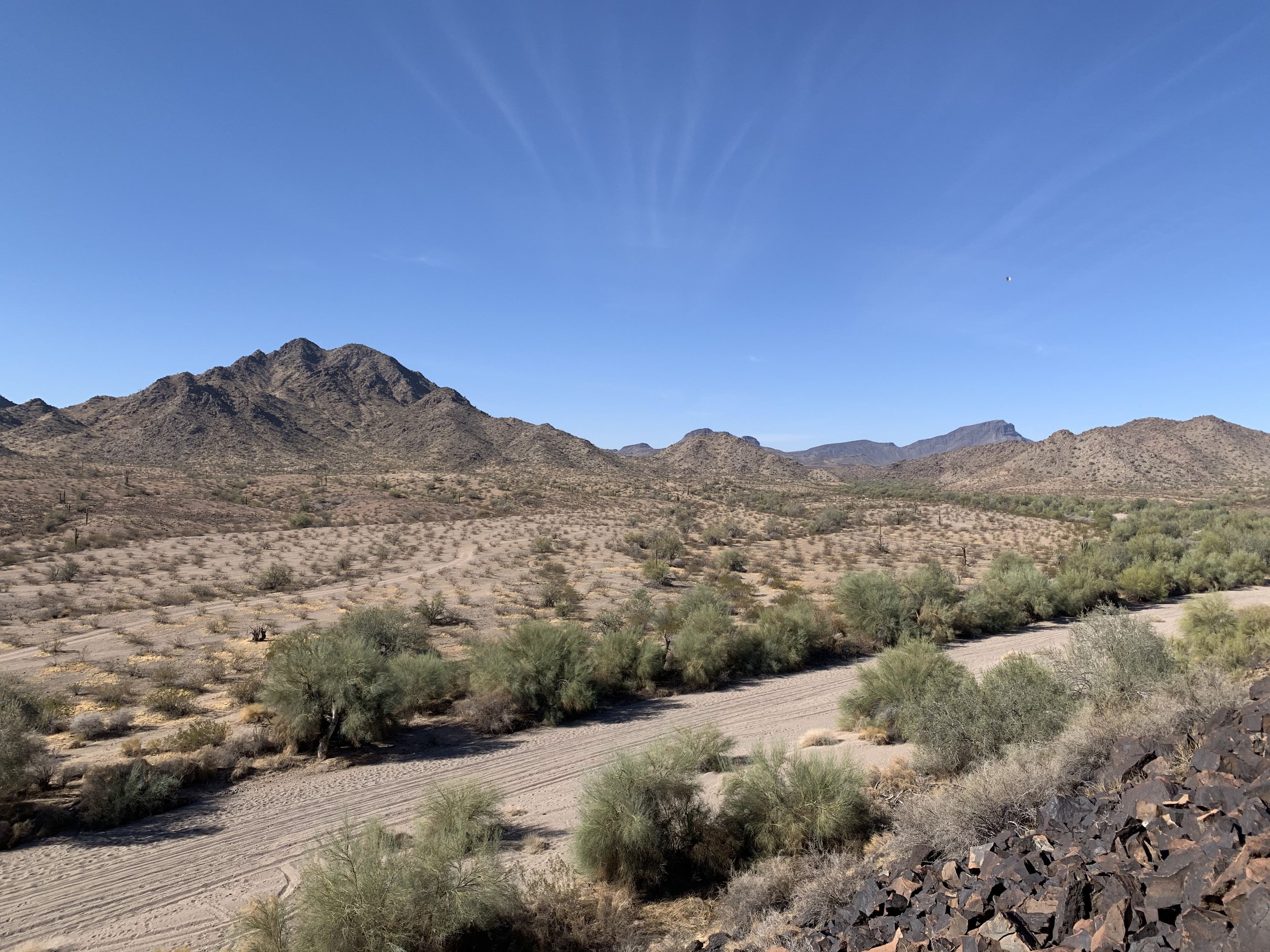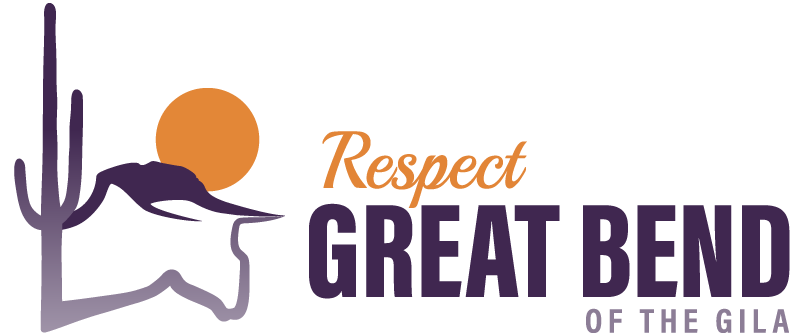
A Path to Permanent Protection
The proposed boundaries for the Great Bend of the Gila National Monument.
What is the plan?
Every minute, our planet loses an area the size of a football field to urban expansion and land alteration. There will never be a better time than now to protect remaining wildlands. Although existing protections in the Great Bend of the Gila are beneficial, more are needed.
Planning for the protection of irreplaceable natural and cultural landscapes helps ensure that people will be able to experience these places for generations. Tribes, local communities, conservationists, and elected officials—recognizing the need to safeguard these lands—have long advocated for stronger protections.
Although the specific initiatives and boundaries of a Great Bend of the Gila protected area have shifted through time, the values of the region and the goal of preservation remain constant. Our coalition is united in efforts to permanently protect this landscape. We are advocating for the designation of a Great Bend of the Gila National Monument.
It’s time to commit to the conservation of this inimitable, enduring—yet surprisingly fragile—landscape. It is also time to include the sovereign Tribal Nations who have connections with the Great Bend of the Gila in protected-area planning and implementation.
What is a National Monument?
The Antiquities Act grants U.S. Presidents the ability to designate federal public lands, waters, and cultural and historical sites as national monuments with a Presidential Proclamation. National monuments are designated to safeguard public lands and waters that have cultural, historic, ecological, and scientific importance to ensure that future generations can enjoy these places.
What are the National Conservation Lands?
The Bureau of Land Management’s National Landscape Conservation System, better known as the National Conservation Lands, is managed to conserve, protect, restore, and enhance America’s national and cultural heritage. National Conservation Lands balance conservation with other compatible uses, including hiking, mountain biking, horseback riding, driving on designated roads, and more. National Conservation Land management can accommodate existing uses, including grazing, energy extraction, power transmission, highways, and structures.
National Conservation Lands provide opportunities for hunting, solitude, wildlife viewing, fishing, history exploration, scientific research, and wide ranges of traditional uses. These special places are homes to threatened and endangered plant and animal species, significant cultural and paleontological resources, and critical wildlife migration corridors and breeding areas.
The communities surrounding these protected lands typically derive significant economic and “sense of place” benefits through tourism and increased regional expenditures on management. Protected areas attract investment, jobs, and sustainable economic and demographic growth.
Why the Great Bend of the Gila?
The Great Bend of the Gila offers a marvelous nexus of natural, cultural, and historical significance representing much of the Southwest’s history and heritage. As its name suggests, here the Gila River winds through a series of “bends'' as it cuts through ancient lava fields and nearby mountain ranges before joining the Colorado River near the Sea of Cortez. As part of the Sonoran Desert, the Great Bend is home to many of the iconic plants and animals the Southwest is so well known for.
For millennia, Indigenous Peoples have called the Great Bend of the Gila home, and the imprints they left behind are still visible. The Gila’s life-sustaining waters enabled these communities to flourish. They built dwellings of stone and adobe, held ceremonies, festivals, and games in their villages, and dug miles of canals to grow a variety of crops. They left their mark on the cliff faces and boulders that line the river valley in the form of petroglyphs and on the surrounding plains as geoglyphs. They traveled and traded with other peoples in distant regions, and in so doing, created an extensive network of trails. The remains of their vibrant cultures—their structures, canals, pottery, trail systems, geoglyphs, and petroglyphs—have stood the test of time and can still be experienced today.
Most of the Great Bend’s archaeology attests to Patayan and Hohokam cultural and agrarian traditions (ancestral Yuman and ancestral O’odham, respectively). These were contemporaneous yet contrasting ways of life that overlapped in the region. Over time, those customs merged and diversified, ultimately becoming the Indigenous traditions that continue today. At least 13 federally recognized Tribes have cultural, historical, and ancestral ties to the Great Bend of the Gila. These ties live on through oral and written history, story, song, ceremony, pilgrimage, and other traditions and ways of knowing.
In addition to living and farming in the Great Bend, people have used the Gila River valley as a travel corridor for millennia. Several ancient and significant Indigenous trails cross this terrain. With the coming of colonialists, the valley also became an overland route between Spanish settlements in Sonora and missions along the California coast. Father Eusebio Kino blazed this trail in the late 1699, and Juan Bautista de Anza formalized it in 1775.
The Anza Trail served as the foundation for many subsequent transcontinental trails and roads, including Kearny’s trail for the Army of the West, Cooke’s Wagon Road for the Mormon Battalion, and the Butterfield Overland Stage Line. Stage stations and Euro-American settler communities began springing up along these routes in the 1860s. One of these, Stanwix Ranch, was the site of the westernmost skirmish of the Civil War.
What threatens the Great Bend of the Gila?
Regional population growth increases recreational use of public lands. Planning for the protection of irreplaceable natural and cultural landscapes helps ensure these places can be experienced by current and future generations. Specific threats to the region include vandalism and theft of cultural resources spread across the lower Gila. These same resources also face the threat of irreparable damage from target shooting which often manifests as litter from bullet casings and targets. Geoglyphs, cryptobiotic soils, plant, and animal life face threats from off-road vehicles driving unimpeded across the open desert landscape. And although resource extraction is not currently a threat, designation as a NCA would eliminate the potential for this into the future.
What threatens the region’s plants and animals?
The Sonoran Desert ranks number one in biodiversity among the deserts of the U.S., and this is on full display in the Great Bend of the Gila. Here, one can walk among towering saguaros and ocotillos while carefully weaving around dozens of cholla and cacti species. One must take care not to trample cryptobiotic soils and to give ample space to the dagger-like agave and yucca leaves while admiring the palo verde, ironwood, and mesquite trees.
The area is home to much of the wildlife the Southwest is recognized for, and it serves as a travel corridor for animals traveling from one part of the Sonoran Desert to another. The Great Bend is home to many species of reptile, among them the iconic Gila monster, Sidewinder, rattlesnakes, and horned toads. More than 200 species of birds, including owls and raptors, can be seen flying above the Great Bend. Arachnids such as scorpions and tarantulas and insects such as the giant desert centipede and tarantula hawk all make homes in the area. Mammals in the region include mountain lions, bobcats, mule deer, javelina, coyote, fox, Desert Bighorn sheep and many more not listed here. Some of these species are endangered, such as the Sonoran pronghorn and the Lesser long-nosed bat. Travel corridors and intact habitat are critically important to their survival, but are becoming rarer due to urban development.
What is Wilderness?
Wilderness is the term used for the government’s highest form of land protection—federally designated wilderness. Wilderness designation directs land management agencies to prioritize the natural functioning of the land.
A notable element of Wilderness is the prohibition of motorized and mechanical transport. In addition to protecting land and wildlife from these pressures, this also ensures places and opportunities for quiet human recreation and solitude.
By protecting Wilderness, we are safeguarding for current and future generations the outdoor spaces enjoyed by every American. Wilderness areas are designated by Congress on federal public lands. The Wilderness Act established the National Wilderness Preservation System (NWPS) to include all designated Wilderness areas. The NWPS now includes 111 million acres in hundreds of Wilderness areas.
The proposed Great Bend of the Gila National Monument has two currently existing Wilderness Areas within its boundaries.
